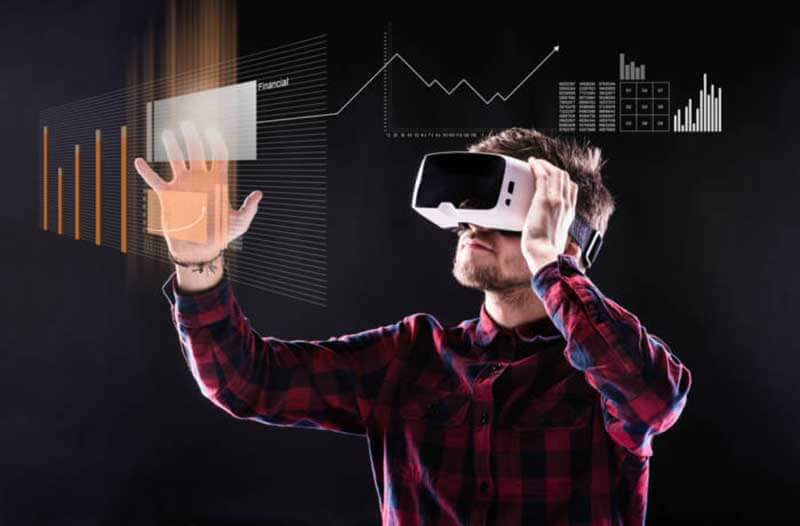- VR and AR offer new channels to reach the Millennials
- Enhancing the brick and mortar bank branch with augmented reality
- The virtual bank branch experience
- 3D visualisation and mixed reality enrich financial traders’ user experience
- VR provides immersive learning experience to educate children about money
Considering the enormous potential of virtual reality and augmented reality technology, the financial services industry is among those eagerly testing the tech. But how could VR and AR revolutionise the finance industry? Well, both technologies have the incredible potential to immerse customers within various types of content and enable them to interact with it. This transforms otherwise complicated, boring content into vivid experiences and new channels of communication for financial services providers. In this article we will take a look ahead to the future of finance that’s a lot closer than we might think.
VR and AR are already very much a part of the real world
We tend to think that virtual and augmented reality technology belongs in the gaming and entertainment world, but nothing could be further from the truth. The tech is already very much a part of the real world, with industries like retail, tourism, education, real estate and healthcare among the early adopters. The ways in which VR and AR can revolutionise the finance industry are many. Financial transactions via smartphones and other mobile devices are on the rise and augmented reality can dramatically personalise and enhance the customer experience. It can, for instance, locate all potential banking channels, offer targeted location-based deals and generally make account management extremely efficient. With augmented reality, efforts such as searching for property, getting an insurance policy and transferring money become seamless and effortless.

VR and AR offer new channels to reach the Millennials
The core of banking consumers consists of Millennials and because this group, with their penchant for new technology, increasingly chooses financial offerings from PayPal, Apple and Google over their traditional, local bank branches, this banking core is slowly but surely disappearing. Industry experts estimate that in the near future, 33% of Millennials won’t need a bank at all. They struggle to engage with traditional, unexciting banking activities. Immersing this generation in a familiar, visually engaging experience is a good way to transform financial data and transactions, make it more appealing and get this group of customers back. Think user-friendly, customer-centric designed apps that make it possible to import transactions from existing banks – the kind of stuff that’s expected by the smartphone generation of today. VR and AR offer new opportunities to engage these Millennials in ways they’re accustomed to and various financial institutions have already taken steps toward the adoption of these technologies. Australian Bank Westpac, for instance, is releasing an augmented reality app for mobile devices. The app provides 3D visualisations of transaction history and balances. It also overlays details over Westpac bank branches in the area.
Enhancing the brick-and-mortar bank branch with augmented reality
To combat the threat of losing even more customers to digital channels, bank branches will have to make a radical shift in their look and feel. Their focus will have to be on making their customers feel welcome and comfortable by offering support and personal advice, as an addition to mobile banking. Bank branches focusing more on advisory roles, rather than sales roles, will create trustworthy, emotional relationships with their clients. Along with this shift towards ‘personal’ relationships, they will have to adopt technologies like virtual reality and augmented reality.
Augmented reality enables customers to drill deeper on required information. The current interactive screens in brick-and-mortar bank branches are generally not very popular as customers don’t feel comfortable using financial tools such as loan calculators that other clients at the bank can easily see. Using QR codes on posters could launch augmented reality apps. These give access to videos, tools and all kinds of other information on the privacy of the user’s smartphone, tablet or wearable, enabling the client to make actionable decisions at the branch.
Various banks have created augmented reality apps to help clients find their way to the nearest branches and ATMs while navigating through the city. Through these apps, the user can view real-time information on the closest branch, such as the distance and services offered. The app also enables them to make an appointment with a financial advisor.
With iBeacon technology, customers walking past such a beacon upon entering the bank will be instantly recognised by bank staff (but only after the customer opts in, of course). Via AR-enabled displays, projecting real-time information in their line of sight, bank staff will have instant access to customer profiles, enabling them to greet the customer by his or her name. This leads to instant personalisation and increased service efficiency. It’s human nature, we enjoy it when a retail store, hotel or even a bank branch welcomes us back with staff knowing our name and basic details before we even provide it.
The virtual bank branch experience
With virtual reality, a world can be created in which customers virtually enter a bank and talk to a bank teller, without having to leave their home or work. Commerzbank, the second largest bank in Germany, is the first commercial bank to open a virtual branch. Since it’s opening in November last year, the virtual bank has shown great popularity among its customers, with the number of people wishing to bank in virtual form far exceeding the bank’s expectations. The virtual bank branch, called LiveBank, aims to fill the gap between Internet banking and customer service at the physical bank branch. At LiveBank, customers can liaise with virtual advisors who are immediately available. The virtual bank offers audio, video and chat communication, enabling customer authorisation and authentication, as well as the option to carry out safe bank transactions and convenient online exchange of documents. Other services offered by LiveBank are the ability to submit various applications, purchase banking products and change banking limits. Virtual banks offer their clients efficient service anywhere and at any time of day or night – which is exactly what modern customers want. According to customers, the number one benefit of LiveBank is that it somewhat restores the personal, face-to-face connection that has gotten lost with the transition to Internet and cell phone banking.
3D visualisation and mixed reality enrich financial traders’ user experience
Navigating through up to eight different screens, each with various windows and tabs containing never ending streams of data in various formats – and instantly making sense of this data – is one of a financial trader’s most challenging tasks. These 2D data streams are often complicated to process, prioritise and accurately extract meaning from. Understandably, financial traders struggle with recognising critical patterns and market changes as well as the lack of collaboration and dialogue.
In order to address these challenges, traders at Citibank have been using working prototypes of the Holographic Workstation, developed with Studio 8ninths (a Microsoft Holographic Academy graduate) and Microsoft HoloLens. These workstations enable traders to experience high-level market conditions through 3D holograms of real-time financial data. Studio 8ninths were able to create an environment in which visual ‘noise’ is reduced and navigation efficiency increased. The information is communicated in a non-obtrusive way; a colourful bubble-map of the financial market enables the trader to understand changes in the trading environment with just one glance. This eliminates the need for complicated data scrutinising. Furthermore, the combination of 2D and 3D makes it easy to extrapolate insights from data streams. With tools such as 3D spheres, particle clouds and colour-coded asset classes, the trader can quickly see what’s happening in the market and zoom in for an in-depth look. The actual, physical workstation – apart from the existing Citibank workflow systems – features spaces for tablet screens and 3D holographic docking and integrates keyboard, mouse, voice, gesture and gaze input options.
VR provides immersive learning experience to educate children about money
When it comes to money management and personal finance, the educational systems currently in place leave quite a bit to be desired. Teaching kids how to save, invest and manage money and how to make various other smart financial decisions is a lot more effective with virtual reality. As part of its free Start Smart financial education program at Australian schools which has been running since 2007, CommBank is currently running pilots with virtual reality technology to teach young kids about earning, spending, saving, and investing money. During the pilot, children take home a system consisting of the Sammy the Space Koala storybook and a VR headset called the Teleporter. A downloadable app is installed on the user’s smartphone which is then inserted into the Teleporter headset. The objective of the pilot is to provide an interactive educational experience that focuses on the differences between ‘needing’ and ‘wanting’. The concept was created with input from paediatricians, education professionals and gaming designers. By making money management engaging, interactive and fun, students will be given the competence and confidence to make smart financial decisions. It is hoped that the pilot will reiterate the power of virtual reality when it comes to subjects that are challenging to teach – such as financial management.
Exciting times for the financial services industry
With AR and VR now functional as well as becoming more affordable, financial services providers should look at these technologies not only as a way to show their ability to innovate, but also as an opportunity to transform their customer experience. VR and AR provide banks and other financial service providers with the opportunity to gain market share with the Millennials and future generations. Ignoring this opportunity means running the risk of being too late to adapt to the disruption of technology and losing out. Banks need to accept VR and AR as promising features of the banking experience of the future.





